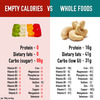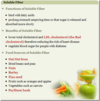Nutrition Flashcards
Calorie
The amount of heat needed to raise the temperature of kg of water by 1° C.
Used as a measure of food energy.
More correctly called kilocalorie.

Empty Calorie
A food that supplies few nutrients per calorie.

6 Kinds of Nutrients
- Carbohydrates 2. Fats 3. Proteins 4. Vitamins - A,B (1, 2, 3, 9, 12), C, D, E) 5. Minerals - Calcium and Iron 6. Water

Nutrient Density
The amount of nutrients per calorie in a food.

Carbohydrates
Any group of compounds, including starches and sugars, that supply energy to the body.

Ketone Body
A toxic compound that can form in the blood if fats are burned with no carbohydrates present.

Ketosis
Occurs if too many Ketone Bodies are present, as a result of consuming insufficient carbohydrates. Blood becomes unable to carry oxygen properly.

Fiber
A group of indigestible carbohydrates found in grains, fruits, and vegetables.

Soluble Fiber
Fiber that absorbs water and forms a kind of gel. It’s found inside and between plant cells.

Insoluble Fiber
Fiber that absorbs less water than soluble fiber and forms bulk in the intestines. It’s found in the cell walls and other structural parts of plants.

Fat
-Fats supply energy to the body in a highly concentrated form. -Some fatty acids are necessary for regulating certain body functions. -Fats act as a carrier for fat-soluble vitamins (Vitamins A,D,E, and K)

Saturated Fat
A fat that is normally solid at room temperature. Major Sources of Saturated Fats 1. Animal Products- meats, poultry, fish, eggs, dairy products 2. Solid Shortenings 3. Tropical oils such as coconut oil and palm kernel oil Health experts believe that these fats contribute significantly to heart disease and other health problems

Monounsaturated Fat
A fat that is liquid at room temperature. Considered to be more healthful than Saturated Fats, although too much of any fat is unhealthy. Major Sources of Monounsaturated Fats 1. Olive & Canola Oil 2. Whole Grains 3. Nuts 4. Some Fruits & Vegetables

Polyunsaturated Fat
A fat that is liquid at room temperature. Considered to be more healthful than Saturated Fats, although too much of any fat is unhealthy. Major Sources of Polyunsaturated Fats 1. Vegetable Oils (including- Corn, Safflower, Sunflower, and Cottonseed) 2. Whole Grains 3. Nuts 4. Some Fruits & Vegetables

Trans fat
These fats only occur naturally in small amounts. Most of the fats in our diet are from manufactured fats subjected to a process called hydrogenation. Trans Fats are a concern because they limit the body’s ability to rid itself of cholesterol that builds up on the walls of arteries

Hydrogenation
Fats changed from liquid to solid by adding hydrogen atoms to the fat molecules. This is the process used to make products such as solid shortening and margarine.

Lipid
Any of a group of compounds that includes fats and cholesterol.

Cholesterol
A fatty substance found in foods derived from animal products and in the human body. Has been linked to heart disease

Essential Fatty Acid
A fatty-acid that must be consumed in the diet because it can’t be made by the body.

Omega-3 Fatty Acid
One of a family of essential unsaturated fatty acids that play vital roles in: 1. Growth 2. Immune System 3. Proper Eyesight 4. Cell Structure -Consists of three major nutrients: ALA, DHA, and EPA

Protein
The building blocks of the body. Consists of substances called amino acids. Essential for: 1. Growth 2. Building Body Tissues 3. Basic Body Functions Can be used for energy if the diet doesn’t contain enough carbohydrate and fat.

Complete Protein
A protein that contains all 9 Essential Amino Acids (amino acids in which the body can’t manufacture, so we must get from food) Contain Complete Proteins: 1. Meat 2. Poultry 3. Fish 4. Eggs 5. Dairy Products

Amino Acid
Long chains of smaller compounds that, when joined in various combinations, make up over 100,000 proteins in the human body.

Complementary Protein
Proteins supplied by foods that, if eaten together, supply all the amino acids necessary in the human diet. Example: Cornmeal tortillas topped with chili bean supply complete protein because the corn supplies the amino acids lacking in the beans.



















